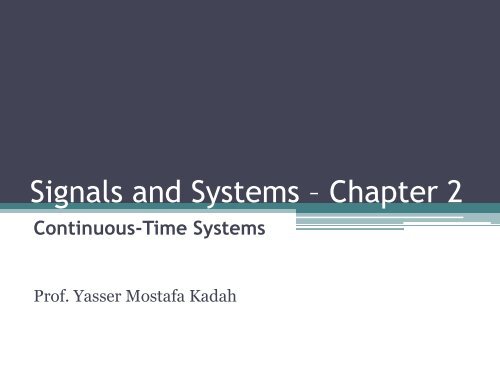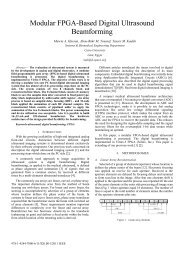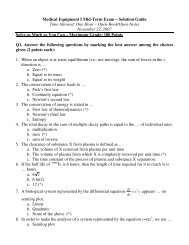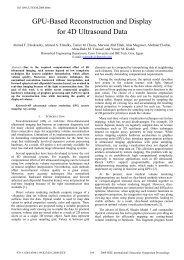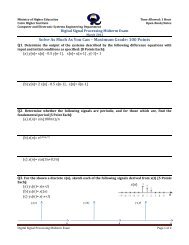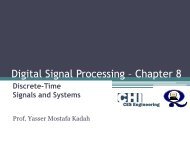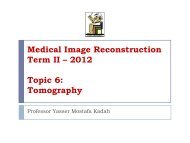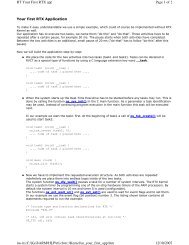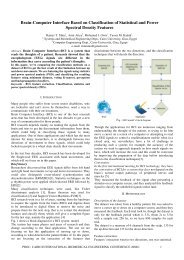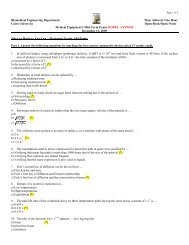Signals and Systems â Chapter 2 - Yasser Kadah's Home Page
Signals and Systems â Chapter 2 - Yasser Kadah's Home Page
Signals and Systems â Chapter 2 - Yasser Kadah's Home Page
You also want an ePaper? Increase the reach of your titles
YUMPU automatically turns print PDFs into web optimized ePapers that Google loves.
<strong>Signals</strong> <strong>and</strong> <strong>Systems</strong> – <strong>Chapter</strong> 2<br />
Continuous-Time <strong>Systems</strong><br />
Prof. <strong>Yasser</strong> Mostafa Kadah
Overview of <strong>Chapter</strong> 2<br />
• <strong>Systems</strong> <strong>and</strong> their classification<br />
• Linear time-invariant systems
“System” Concept<br />
• Mathematical transformation of an input signal<br />
(or signals) into an output signal (or signals)<br />
▫ Idealized model of the physical device or process<br />
• Examples:<br />
▫ Electrical/electronic circuits<br />
• In practice, the model <strong>and</strong> the mathematical<br />
representation are not unique
System Classification<br />
• Static or dynamic systems<br />
▫ Capability of storing energy, or remembering state<br />
• Lumped- or distributed-parameter systems<br />
• Passive or active systems<br />
▫ Ex: circuits elements<br />
• Continuous time, discrete time, digital, or hybrid<br />
systems<br />
▫ According to type of input/output signals
LTI Continuous-Time <strong>Systems</strong><br />
• A continuous-time system is a system in which<br />
the signals at its input <strong>and</strong> output are<br />
continuous-time signals
Linearity<br />
• A linear system is a system in which the<br />
superposition holds<br />
Output<br />
▫ Scaling<br />
▫ Additivity<br />
Linear<br />
System<br />
input<br />
Output<br />
Nonlinear<br />
System<br />
• Examples:<br />
▫ y(x)= a x<br />
▫ y(x)= a x + b<br />
Linear<br />
Nonlinear<br />
input
Linearity – Examples<br />
• Show that the following systems are nonlinear:<br />
▫ where x(t) is the input <strong>and</strong> y(t), z(t), <strong>and</strong> v(t) are<br />
the outputs.<br />
Whenever the explicit relation between the input <strong>and</strong> the output of a<br />
system is represented by a nonlinear expression the system is nonlinear
Linearity – Examples<br />
• Consider each of the components of an RLC<br />
circuit <strong>and</strong> determine under what conditions<br />
they are linear.<br />
▫ R<br />
▫ C<br />
▫ L
Linearity – Examples<br />
• Op Amp<br />
▫ Linear or nonlinear region<br />
• Virtual short
Time Invariance<br />
• System S does not change with time<br />
▫ System does not age—its parameters are constant<br />
• Example: AM modulation
RLC Circuits<br />
• Kirchhoff’s voltage law,<br />
d/dt<br />
• Second-order differential equation with constant<br />
coefficients<br />
▫ Input the voltage source v(t)<br />
▫ Output the current i(t)
Representation of <strong>Systems</strong> by<br />
Differential Equations<br />
• Given a dynamic system represented by a linear<br />
differential equation with constant coefficients:<br />
▫ N initial conditions:<br />
▫ Input x(t)=0 for t < 0,<br />
• Complete response y(t) for t>=0 has two parts:<br />
▫ Zero-state response<br />
▫ Zero-input response
Representation of <strong>Systems</strong> by<br />
Differential Equations<br />
• Linear Time-Invariant <strong>Systems</strong><br />
▫ System represented by linear differential equation<br />
with constant coefficients<br />
▫ Initial conditions are all zero<br />
▫ Output depends exclusively on input only<br />
• Nonlinear <strong>Systems</strong><br />
▫ Nonzero initial conditions means nonlinearity<br />
▫ Can also be time-varying
Representation of <strong>Systems</strong> by<br />
Differential Equations<br />
• Define derivative operator D as,<br />
• Then,
Analog Mechanical <strong>Systems</strong>
Application of Superposition <strong>and</strong><br />
Time Invariance<br />
• The computation of the output of an LTI system is<br />
simplified when the input can be represented as the<br />
combination of signals for which we know their response.<br />
▫ Using superposition <strong>and</strong> time invariance properties
Application of Superposition <strong>and</strong><br />
Time Invariance: Example<br />
• Example 1: Given the response of an RL circuit to a unitstep<br />
source u(t), find the response to a pulse
Convolution Integral<br />
• Generic representation of a signal:<br />
• The impulse response of an analog LTI system, h(t), is the<br />
output of the system corresponding to an impulse (t) as<br />
input, <strong>and</strong> zero initial conditions<br />
• The response of an LTI system S represented by its impulse<br />
response h(t) to any signal x(t) is given by:<br />
Convolution<br />
Integral
Convolution Integral: Observations<br />
• Impulse response is fundamental in the characterization<br />
of linear time-invariant systems<br />
• Any system characterized by the convolution integral is<br />
linear <strong>and</strong> time invariant by the above construction<br />
• The convolution integral is a general representation of<br />
LTI systems, given that it was obtained from a generic<br />
representation of the input signal<br />
• Given that a system represented by a linear differential<br />
equation with constant coefficients <strong>and</strong> no initial<br />
conditions, or input, before t=0 is LTI, one should be<br />
able to represent that system by a convolution integral<br />
after finding its impulse response h(t)
Convolution Integral: Example<br />
• Example: Obtain the impulse response of a capacitor <strong>and</strong><br />
use it to find its unit-step response by means of the<br />
convolution integral. Let C = 1 F.
Causality<br />
• A continuous-time system S is called causal if:<br />
▫ Whenever the input x(t)=0 <strong>and</strong> there are no initial<br />
conditions, the output is y(t)=0<br />
▫ The output y(t) does not depend on future inputs<br />
• For a value > 0, when considering causality it is helpful<br />
to think of:<br />
▫ Time t (the time at which the output y(t) is being<br />
computed) as the present<br />
▫ Times t- as the past<br />
▫ Times t+ as the future
Causality
Graphical Computation of<br />
Convolution Integral<br />
• Example 1: Graphically find the unit-step y(t) response<br />
of an averager, with T=1 sec, which has an impulse<br />
response h(t)= u(t)-u(t-1)
Graphical Computation of<br />
Convolution Integral<br />
• Example 2: Consider the graphical computation of the<br />
convolution integral of two pulses of the same duration
Interconnection of <strong>Systems</strong>—<br />
Block Diagrams<br />
• (a) Cascade (commutative)<br />
• (b) Parallel (distributive)<br />
• (c) Feedback
Bounded-Input Bounded-Output<br />
Stability (BIBO)<br />
• For a bounded (i.e., well-behaved) input x(t), the output<br />
of a BIBO stable system y(t) is also bounded<br />
• An LTI system with an absolutely integrable impulse<br />
response is BIBO stable<br />
• Example: Multi-echo path system
Problem Assignments<br />
• Problems: 2.3, 2.4, 2.8, 2.9, 2.10, 2.12, 2.14<br />
• Partial Solutions available from the student<br />
section of the textbook web site


